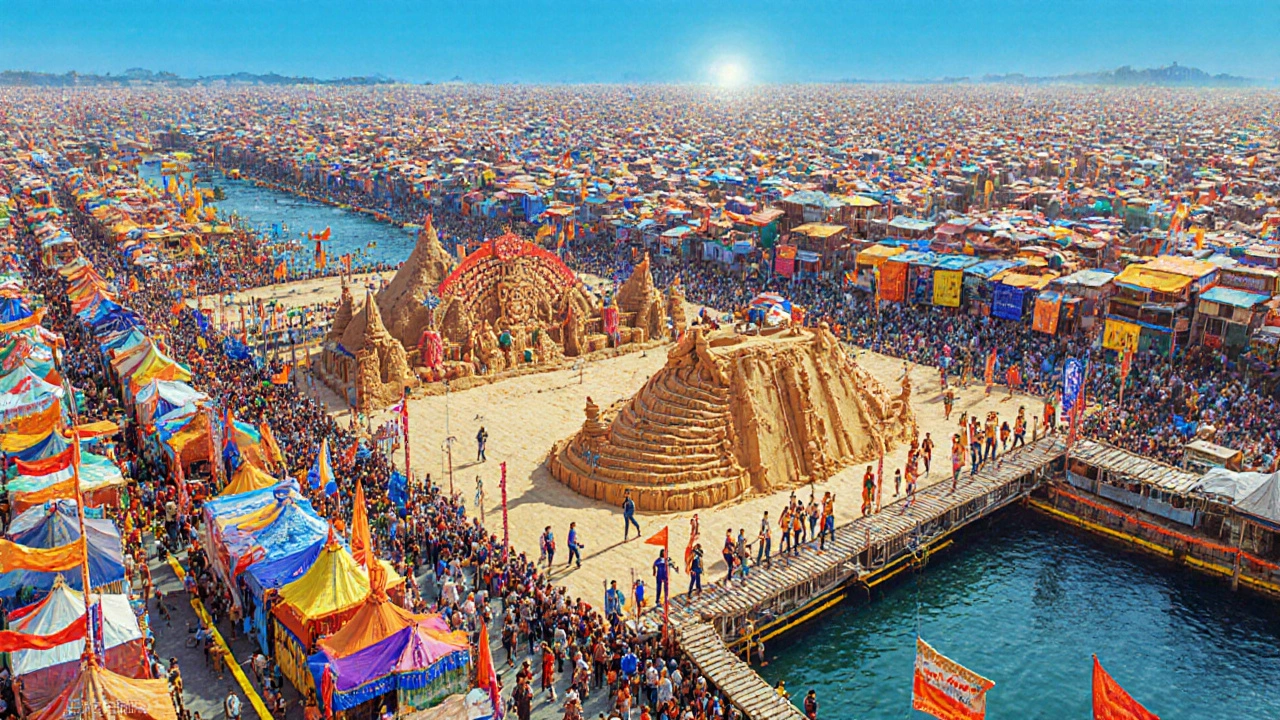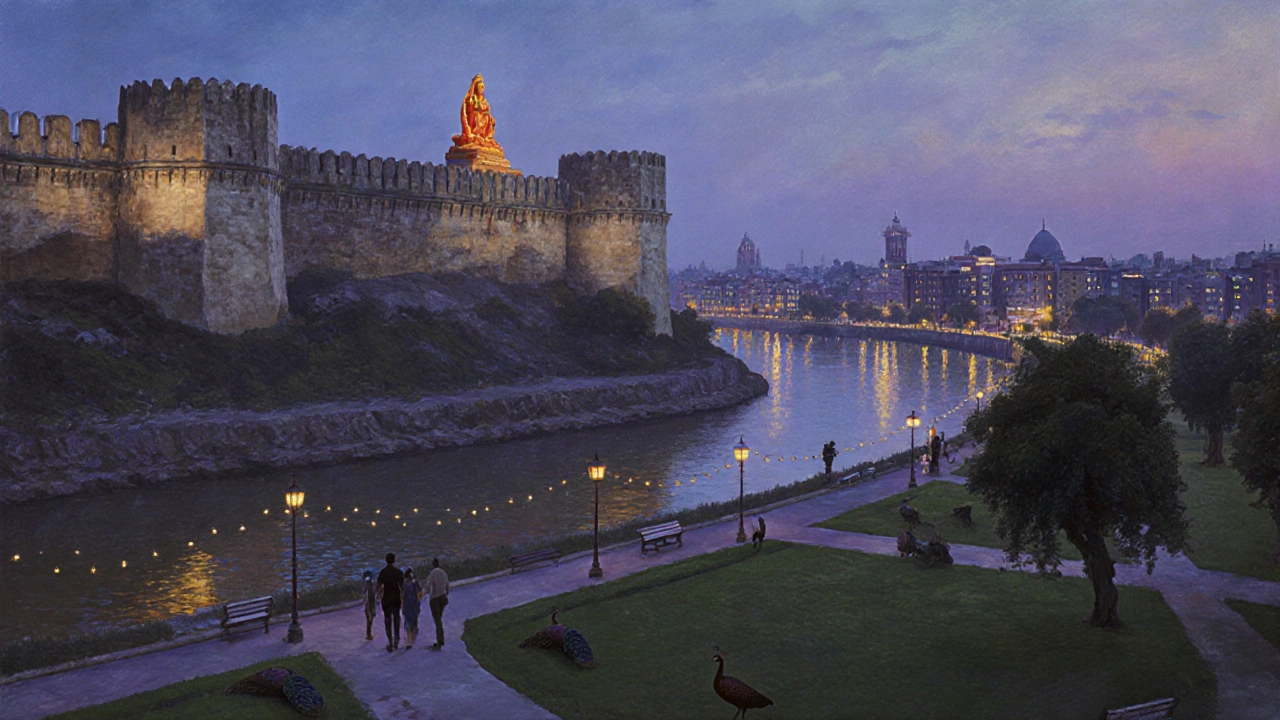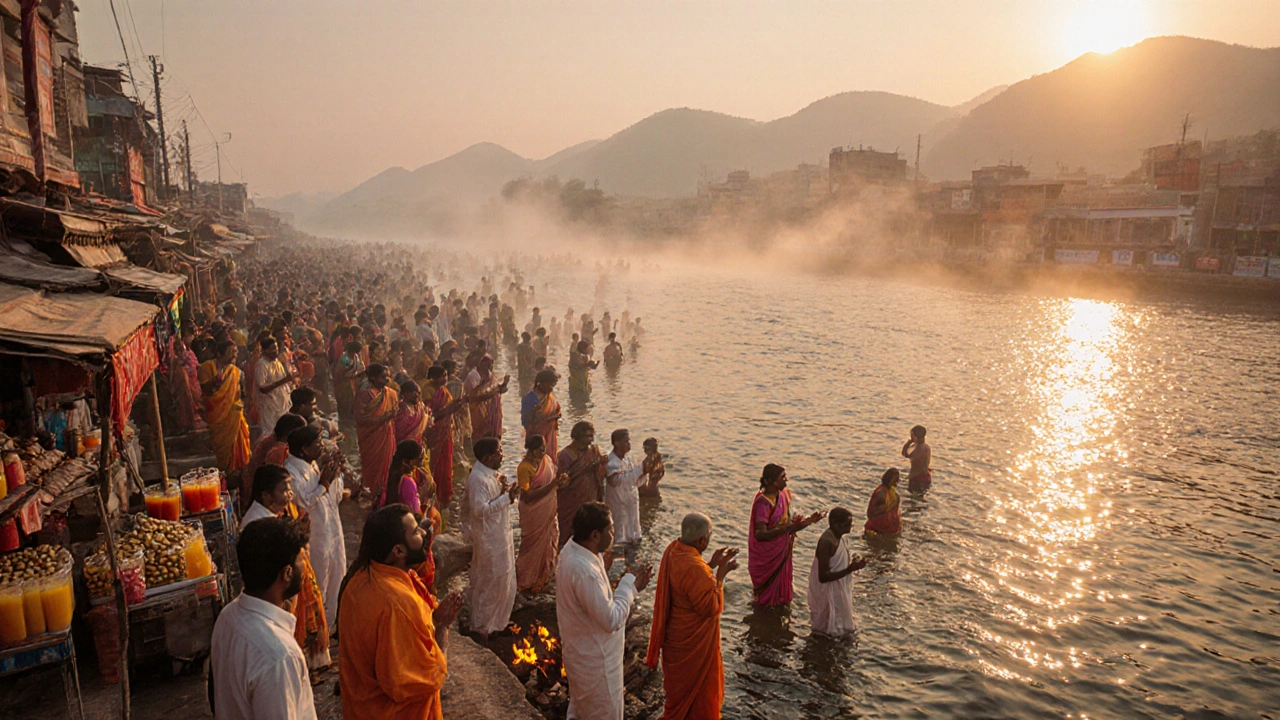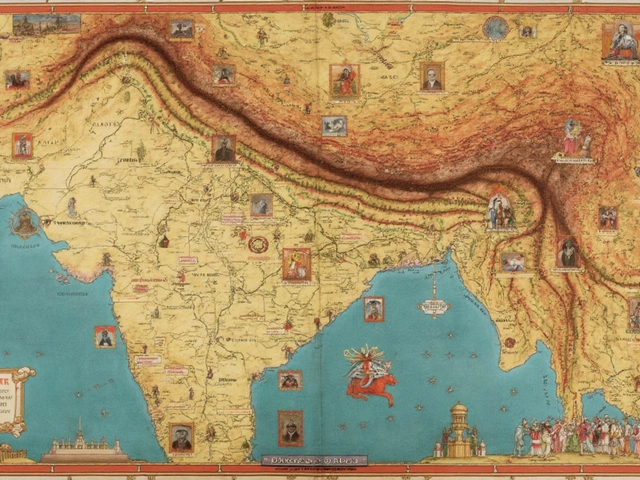Discover the Unique Attractions and Heritage of Prayagraj
When you hear the name Prayagraj is a historic city in northern India where the Ganges, Yamuna, and the mythical Saraswati rivers converge. Known for its religious significance, colonial architecture, and vibrant cultural scene, the city offers a mix of spiritual pilgrimage, royal heritage, and modern bustle.
Key Takeaways
- Prayagraj is the only Indian city with a Triveni Sangam-the confluence of three rivers-making it a major pilgrimage hub.
- The Kumbh Mela held every 12 years draws millions for a world‑class spiritual festival.
- Historical sites like Allahabad Fort and Anand Bhawan showcase Mughal and British eras.
- Educational landmarks such as University of Allahabad add an intellectual flavor to the city.
- Practical tips-best travel months, local transport, and food must‑tries-make a visit smooth and memorable.
The Sacred Confluence: Triveni Sangam
At the heart of Prayagraj lies the Triveni Sangam the meeting point of the Ganges, Yamuna, and the invisible Saraswati rivers. Pilgrims believe that taking a dip here washes away sins and grants spiritual merit. Early morning ceremonies feature priests chanting Vedic mantras while locals sprinkle holy water on visitors.
For first‑timers, the best time to experience the Sangam is during the winter months (late November to February) when the weather is cool and the riverbanks are less crowded. Even if you’re not religious, the sight of the three waters swirling together is striking-and you’ll find street vendors selling fresh juice, roasted peanuts, and traditional sweets like peda.
Kumbh Mela - The World’s Largest Gathering
The Kumbh Mela transforms Prayagraj into a temporary city of tents, makeshift hospitals, and cultural showcases. Held every 12 years, the next edition is slated for 2027, but the city hosts a smaller Ardh Kumbh every six years, drawing hundreds of thousands.
What makes the Kumbh unique? Besides the religious rituals, you’ll see a kaleidoscope of regional dances, folk music, and even a massive sand sculpture contest. Logistics are impressive-temporary bridges, dedicated police corridors, and a multilingual information system ensure safety for the massive crowds.
Royal Relics: Allahabad Fort and Anand Bhawan
Built by the Mughal emperor Akbar in the 16thcentury, Allahabad Fort sits on a hill overlooking the Sangam. Though much of the interior is a government office, the fort’s massive walls, cannons, and the impressive “Bharat Mata” statue are open to the public. The view from the top offers a panoramic sweep of the rivers and the city’s skyline.
Just a short drive away, Anand Bhawan was the residence of the Nehru‑Gandhi family. Now a museum, it houses original letters, photographs, and personal artefacts of Jawaharlal Nehru, Indira Gandhi, and Rajiv Gandhi. Guided tours highlight India’s independence movement, making it a must‑visit for history buffs.

Intellectual Heritage: University of Allahabad and Allahabad Museum
Founded in 1887, the University of Allahabad claims the title of “the mother of Indian universities.” Its Gothic‑style campus, complete with sprawling lawns and colonial‑era buildings, still buzzes with students from across the country. Visitors can join a short campus walk to see the historic senate hall and the Mahatma Gandhi statue.
Adjacent to the university, the Allahabad Museum showcases an eclectic mix of artifacts: ancient sculptures, rare manuscripts, and a complete set of ‘Mughal miniatures.’ A special exhibit on the Prayagraj Kumbh Mela’s evolution is usually on display, providing a visual narrative of the city’s spiritual journey.
Colonial Charms: Civil Lines and the Railway Junction
During the British Raj, Prayagraj’s elite area was called Civil Lines. Today, the broad avenues, tree‑lined boulevards, and heritage bungalows give the neighbourhood a relaxed, upscale vibe. Cafés serve a mix of Indian chai and Western pastries-perfect for a mid‑day break after temple hopping.
The city’s transport hub, Prayagraj Junction, is one of India’s busiest railway stations. Its historic façade, built in 1883, blends Indo‑Sarc‑British architecture. Travelers can catch trains to Delhi, Kolkata, and Varanasi, making Prayagraj a convenient base for exploring northern India.
Green Escapes and Riverside Walks
Nature lovers should head to Minto Park (officially Phool Bagh). The park’s lush lawns, flowering trees, and a miniature lake provide a calm retreat. Early mornings bring joggers, yoga groups, and families feeding the resident peacocks.
Another scenic spot is the Yamuna Riverfront Walk. Recent municipal upgrades added illuminated pathways, benches, and informational plaques about the river’s mythology. Evening walks here offer spectacular sunset reflections over the water.

Practical Tips for Visiting Prayagraj
- Best months: November to February for cool weather; avoid the monsoon (July‑September) when streets can flood.
- How to get there: Fly into Prayagraj Airport (small but well‑connected) or take a train to Prayagraj Junction. The city’s auto‑rickshaws and app‑based taxis are inexpensive.
- Dress code: Light cottons for day; modest attire (shoulders covered) when visiting temples or the Sangam.
- Food highlights: Try kebabs from the Chowk market, the sweet jalebi near Anand Bhawan, and the famous panipuri roadside stalls.
- Safety: Keep valuables close, especially during large gatherings like the Kumbh Mela. Carry a small bottle of hand sanitizer and stay hydrated.
Top Attractions at a Glance
| Attraction | Type | Best Time to Visit | Entry Fee (INR) |
|---|---|---|---|
| Triveni Sangam | Spiritual site | Nov‑Feb | Free |
| Kumbh Mela (Ardh) | Festival | Every 6years (next 2027) | Free |
| Allahabad Fort | Historical fort | Oct‑Mar | 30 |
| Anand Bhawan Museum | Heritage museum | Oct‑Mar | 50 |
| Allahabad Museum | Cultural museum | All year | 25 |
Frequently Asked Questions
What is the significance of the Triveni Sangam?
The Sangam is the only place in India where three rivers-the Ganges, Yamuna, and the mythical Saraswati-are believed to meet. Hindus consider a dip there a rite of purification that can erase past sins.
When does the Kumbh Mela occur in Prayagraj?
The full Kumbh Mela happens every 12years; the next one is scheduled for 2027. A smaller Ardh Kumbh takes place every six years, the most recent being in 2021.
Can I visit Allahabad Fort on a budget?
Yes. The fort charges a modest entry fee of INR30 and is open from 9am to 5pm on weekdays. Early mornings are quieter, allowing better photography.
What local dishes should I try while in Prayagraj?
Don’t miss the kebabs from Chowk, the sweet jalebi near the railway station, and the tangy panipuri sold by street vendors. A traditional Thandai is popular during festivals.
Is Prayagraj safe for solo travelers?
Overall, yes. The city’s main tourist areas are well‑policed, especially during festival seasons. Use registered taxis or app‑based rides, keep an eye on belongings, and stay hydrated.






8 Comments
Deepak Sungra
October 9 2025Well, I finally skimmed through the guide on Prayagraj and, honestly, it reads like a travel brochure written on a caffeine high. The whole Triveni Sangam thing sounds magical, but you’d think they’d mention how crowded it gets in winter. Also, the food tips are solid – those kebabs are legendary. I’m still not convinced about the “must‑see” label for the university, though; it feels more like a photo‑op spot. Anyway, nice effort, I guess.
Samar Omar
October 16 2025Allow me to indulge in a thorough exegesis of the post, for those readers who crave a more erudite perspective. The author’s portrayal of the Triveni Sangam, while evocative, fails to acknowledge the profound theological connotations that have been articulated by scholars across centuries, beginning with the Vedic sages and culminating in contemporary postcolonial discourse. Moreover, the brief mention of the Kumbh Mela neglects to situate it within the broader sociopolitical matrix of pilgrimage economies, wherein the convergence of millions catalyzes a transient metamorphosis of urban infrastructures. One must also consider the architectural symbolism of Allahabad Fort; its very stones echo the imperatives of imperial ambition interlaced with indigenous resistance, a nuance the article glosses over. The reference to Anand Bhawan, though accurate, would benefit from a more nuanced discussion of its role as a crucible for the Nehru‑Gandhi lineage’s ideological genesis. The University of Allahabad, lauded as the "mother of Indian universities," warrants a deeper interrogation of its curricular evolution and its impact on intellectual currents during the freedom struggle. The description of the riverfront walk, albeit charming, omits the recent eco‑restoration initiatives that aim to reconcile urban development with environmental stewardship. As for the culinary highlights, the emphasis on kebabs and jalebi, while delightful, diminishes the region’s diverse gastronomic heritage, which includes the subtly spiced litti‑chokha and the aromatic chaat of Chowk. The author’s practical advice, though useful, could be refined by addressing the labyrinthine nature of local transport systems, especially the unregulated auto‑rickshaws that often bewilder first‑time visitors. Finally, the safety tips, while prudent, would be incomplete without a discourse on the complexities of crowd management during the Ardh Kumbh, a subject that has fascinated urban planners worldwide. In summation, the article serves as an introductory overview, yet it invites a more comprehensive, interdisciplinary examination for the discerning traveler.
chioma okwara
October 24 2025Yo the post is gud but u gotta fix a few thingz. Triveni Sangam is spelt triveni sangam not "Triveni Sangam" every time – consistent lower case is better. Also, the word "mythical" before Saraswati is kinda unnecessary, it’s already known that it’s invisible. Last but not least, "Allahabad Fort" is actually in Prayagraj now, so maybe note the name change.
John Fox
October 31 2025Sounds like a decent spot to explore.
Tasha Hernandez
November 8 2025Oh sure, because nothing says "relaxing vacation" like elbow‑to‑elbow crowds and a never‑ending chant of mantras. If you enjoy sweating in a sea of strangers, go for it. Otherwise, maybe pick a quieter riverbank.
Anuj Kumar
November 15 2025People don’t tell you that the government is using the Kumbh to test new surveillance tech. Keep an eye on your phone and avoid the main stages if you value privacy.
mani kandan
November 22 2025If you’re planning a trip, definitely hop on an auto‑rickshaw from the railway station to the Sangam – it’s cheap and you’ll get a quick intro to the city’s street vibe. The best time to catch a train is early morning; you’ll avoid the rush and have more time for sightseeing.
Rahul Borole
November 30 2025Thank you for the practical tips! I would also recommend purchasing a prepaid travel card for the city buses, as it saves both time and hassle with cash. Additionally, consider visiting the Allahabad Museum on a weekday to avoid the weekend crowds and enjoy a more relaxed atmosphere. Finally, the sunset view from the Yamuna Riverfront Walk is truly spectacular – plan to stay a little longer after dinner.